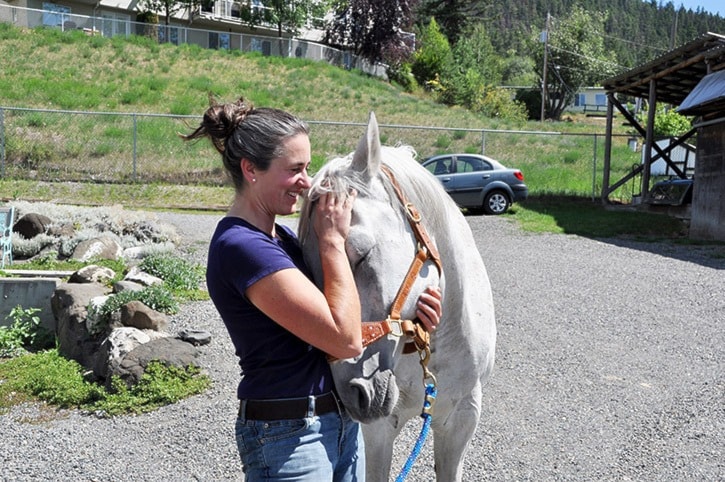Being a veterinarian was a dream from childhood for Williams Lake veterinarian Stefanie Krumsiek.
After graduating from the Veterinary Chiropractic Learning Centre in Brantford, Ont., Krumsiek now brings another set of internationally certified skills to the table.
She said that as a veterinarian she learned the anatomy of livestock, pets and birds and is certified to work on all animals, adding that the focus of the chiropractic course was mainly dogs and horses.
One of the main reasons she wanted to take the course was because of a severe riding accident she sustained when she was 16 years old. “I injured my skull and my cervical spine and in the end, besides hospitalization and being bedridden for about two months, I started having tingling and sensation changes in my fingers,” she explained. “I looked for some alternative treatment options to help me during my rehab process, including chiropractic. It was one of the things that helped me recover. I could really feel the difference.
“I’ve always wanted to be a veterinarian, but after that I knew I also wanted to be able to offer my patients the same kind of treatment that helped me.”
Attending vet school and working in Vienna, she said she saw various alternative treatments used for animals, such as chiropractic, physio therapy, equine massage and acupuncture.
“No matter where you work, it’s all about the animals, big or small. In the end, the animals are all the same and that’s what counts. Animals are animals and they get sick, or they need maintenance care,” she added. “There are people who work with their animals as partners and people whose animals are family members and friends.”
Her chiropractic assessments and treatments, for mainly horses and dogs, are done both at the Williams Lake Veterinarian Hospital and on site. Sometimes, she said, there is a list of horses for her to see in one area, and the owners all bring their animals to one farm or ranch.
She explained that when she sees a horse or a dog the first thing she does is get a history from the owner. “Was there an accident? How is the animal used: as a companion or a working animal? I ask about specific injuries and conditions which can be common depending on what they do for a life,” she said.
“Next is a visual assessment; I watch it move and look for things like general health and symmetry. I won’t do a chiropractic treatment on a horse that’s sick, for example. Maybe its lameness or restricted movement is due to a fever or an abscess.
“I look for signs of muscle asymmetry, and anything related to neurological issues that could cause an abnormal movement.”
She said she doesn’t look at body parts — she looks at the animal as a whole. “I may notice that he drags his toes when he walks or doesn’t want to turn to the left, but I still see him as a whole,” she explained, adding that the main adjustments in dogs and horses are along the spinal column, but that she also does adjustments for front and hind extremities.”
Things that cause a horse to need an adjustment can include the wrong saddle, a trauma, repetitive movements, a bit that doesn’t fit right, she said, or an injury. “A horse used for roping, for example, goes very fast for a short distance and does very rapid turns and stops, which can put a lot of pressure on the sacroiliac joint,” she continued.
When doing a chiropractic adjustment, she checks the muscle mobilization first and said she can tell what hurts. “You can feel resistance; if an animal finds it painful they will let you know. If it’s a dog they may try to bite you; if it’s a horse they may try to kick you,” she noted. “When I do the stretches and there’s resistance, it’s due to pain or constriction.”
Relief from a chiropractic treatment can be almost immediate. “You can tell when it feels better while you’re working on them: when the adjustment is done you can see the animal relax. You can see the breathing pattern change; when a horse relaxes they drop their head and they drop their lower lip; some of them stand like that, looking like they’re half-sedated just from the relief. That’s an awesome feeling — when you see that the animal is actually enjoying it,” she said.
“My biggest satisfaction is when they come for the second or third treatment and they greet me like they really love to see me.”
